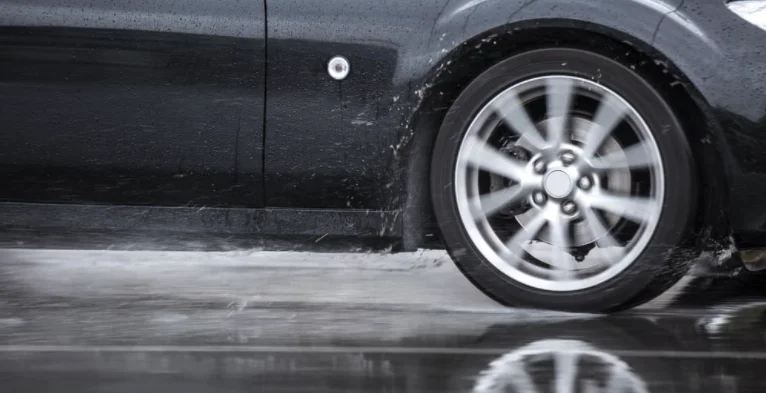
You might have probably felt the vehicle skid or slightly lost steering control when driving on a wet road. Roads tend to get slick whenever the surface is wet, as the thin layer of water results in significant loss of traction, which causes challenges when braking and steering.
What is Hydroplaning?
Water is pushed below the tires due to pressure differences, forming a thin film which reduces tire contact with the road surface. Treads are designed to scatter and channel flowing water under the tires through the grooves.
Driving faster on wet roads increases fluid pressure in front of your tires and reduces the ability of the treads to scatter and disperse the water on the road surface.
How Does Hydroplaning Happen
Wet road conditions increase the probability of a vehicle to hydroplane. There is a high probability of hydroplaning within the first 10 minutes of light rains. Under dry conditions, traces of oil residues are scattered all over the road surface.
When it rains, the oil residue mixes with water droplets, in the process making the road surface slippery. Exceeding speeds of 35 mph under these conditions increases the probability of a car to hydroplane.
When hydroplaning occurs, the driver will feel as though the car is floating or veering off. If the drive wheels hydroplane, engine revolutions and speedometer readings tend to increase and the tires begin to spin. When all four wheels hydroplane, the car will skid forward, maintaining a straight line.

Your Best Defense Against Hydroplaning
Hydroplane skids are spontaneous and last for a few seconds. Whatever the case, it is critical that you maintain calm as you try to keep the vehicle under control. Whenever you feel the vehicle slide when driving on a wet road, take off the foot from the gas pedal.
Instantaneous braking could result in further loss of control. In instances where braking is mandatory, step on the brake pedal, slowly and steadily. You may find it difficult to maintain the car on its course. It is advisable that you try to gently steer the car in the direction of the skid.
Steadily steering wheel movements for a limited number of times helps you to regain traction and ultimately bring the car into full control. Following closely on the tracks of any vehicle that’s in front positions you on a path with thinner films of water, as a considerable amount of surface water is already scattered.
It is riskier to drive immediately when the rain falls. However, as the downpour becomes heavier, puddles on the roads get deeper, further increasing the risk of hydroplaning.
You can reduce your risk of hydroplaning on wet road surfaces by using tires with sufficient tread depths, while maintaining low driving speeds.
FAQ
How much water does it take to hydroplane?
Any small amount of water that renders the road surface wet and slippery could cause your car to hydroplane. Accumulation of water for depths as little as a tenth of an inch creates potential conditions for vehicles driving at medium to high speeds to hydroplane.
Worn out tires with less tread depths increases the chances of a car skidding.
At what speed does hydroplaning occur?
Driving vehicles at speeds above 35 mph raises the likelihood of hydroplaning on wet roads. Speeding in puddles, just after rains increases the risk of hydroplaning, even at much lower speeds. Driving fast, even with good tires with sufficient tread depths increases the possibility of hydroplaning.
What to do if your vehicle hydroplanes
Stay calm and try to regain full control of the vehicle. Release the gas pedal while avoiding any panic braking. Gently steer the vehicle towards the direction of the skid, if it is necessary to apply brakes, do it in a gentle and steady manner. Hydroplaning occurs over a short period of time and you should maintain calm throughout the episode.
Once you regain full control of the vehicle, it is good practice to slow down, driving on lower gears and turning off cruise control. Always be on the lookout, proactively identifying any hydroplaning hazards.


